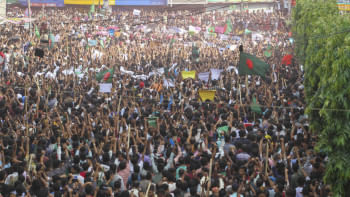Exploring river heritage of Dhaka

We, as residents of this bustling metropolis, have never given much thought to what and who defines the city's economy and culture. We hardly ever give any consideration to how the ghats (river fronts) of Old Dhaka and their related business have had an impact on all sorts of stakeholders in the adjoining area and also how these ghat-related livelihoods impacted the city in turn.
Take Swarighat as a case in point. Fishermen, boatmen, merchants, middlemen, men who supply ice, cleaners and cutters, nearby hostels where these men sleep, hotels where they eat -- all these livelihoods are in motion surrounding the fish market. And their business, in turn, tumbles into the city and that is how the wheel of this mega city runs.

This fine storyline, which is a reflection on how occupation and livelihood in a certain area influence the socio-transitions of Dhaka, is showcased in an exhibition at the Hamidur Rahman Cultural Centre, in collaboration with Alliance Française de Dhaka.
The unusual exhibition, which commenced on November 28 will be open to people until December 5.
"River Heritage: Learning from Puran Dhaka" presents a rich learning experience from the study of eight ghats of Old Dhaka, from Buriganga to Farashganj.
It is EUNIC's (European Union National Institutes for Culture) third chapter on the heritage initiative -- River Heritage -- focusing on the rich cultural and architectural legacy of Puran Dhaka, including its people's way of life, their means of subsistence, and the intricate relationship they maintain between the river and the city.
Their efforts culminated in an array of drawings, maps, plans, observations, photographs, and testimonies from local inhabitants, which are on display.
Narrated through the eyes of young architects, this exhibition is more than a display of creative work; it is a documentation on the urbanity of occupations in Old Dhaka from rivers to the city. That means documenting settlements through some of its significant streetscapes -- residential, religious, educational, social institutions, and the relationship between the river and the occupations along it.
Mohammad Tahajibul Hossain, assistant professor, Department of Architecture, Buet, said, "Through a mix of sketches, measure drawings, photographs and interviews, students recorded the contemporary environment of the Puran Dhaka and developed a template to represent the same for the purpose of architectural conservation efforts, which will be shown at the exhibition."
"Dhaka was born on the banks of Buriganga. It was the centre of trade and commerce at one point and provided livelihood for the people of the city and its periphery. Currently, Ruplal House, the grand 19th century mansion in Farashganj, houses a wholesale market of spices; a soap factory is present at the entrance of Chhota Katra, Mangal Aloy in Shyam Bazar allows people to sleep the night -- these encroachments threaten the buildings and at the same time allows these people to survive.
The main objective of the workshop was to learn and in our two-week observation we feel that if these trades are to be decentralised, we need to think of alternatives to protect them as well. These heritage buildings are sheltering the toiling masses, though these are illegally occupied.
Many livelihoods are dependent in these areas and help local inhabitant, low-income labourers."
"Dhaka still looks at these rivers, so when we think of future urbanisation, we must remember so many stakeholders' dependency in our future policy," explained Hossain.
The programme included Indo-French partners of architecture colleges (ENSAPLAV: Ecole Nationale Supérieure d'Architecture de Paris La Villette, Paris Franc and BVCOA: Bharati Vidyapeeth's College of Architecture, of Navi Mumbai, Maharashtra, India), and College of Architecture Trivandrum (CAT), Kerala, India, and Pathshala School of Photography, Dhaka, Bangladesh and Department of Architecture, Buet.


 For all latest news, follow The Daily Star's Google News channel.
For all latest news, follow The Daily Star's Google News channel. 



Comments